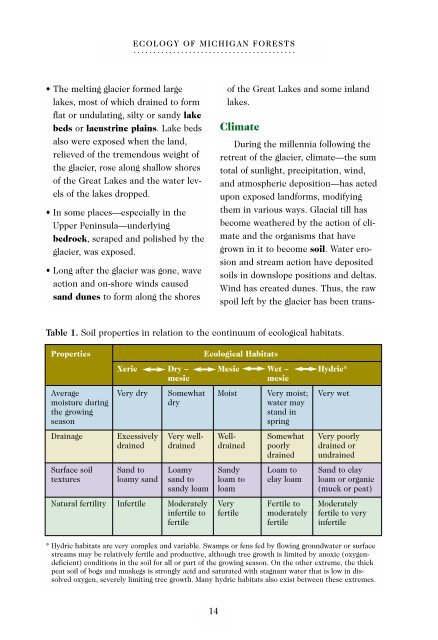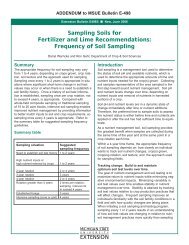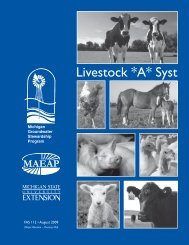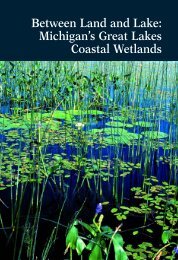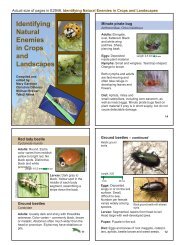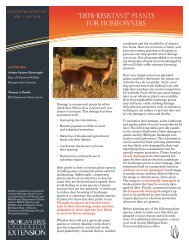Michigan Forest Communities - Michigan Association of ...
Michigan Forest Communities - Michigan Association of ...
Michigan Forest Communities - Michigan Association of ...
Create successful ePaper yourself
Turn your PDF publications into a flip-book with our unique Google optimized e-Paper software.
ECOLOGY OF MICHIGAN FORESTS<br />
• The melting glacier formed large<br />
lakes, most <strong>of</strong> which drained to form<br />
flat or undulating, silty or sandy lake<br />
beds or lacustrine plains. Lake beds<br />
also were exposed when the land,<br />
relieved <strong>of</strong> the tremendous weight <strong>of</strong><br />
the glacier, rose along shallow shores<br />
<strong>of</strong> the Great Lakes and the water levels<br />
<strong>of</strong> the lakes dropped.<br />
• In some places—especially in the<br />
Upper Peninsula—underlying<br />
bedrock, scraped and polished by the<br />
glacier, was exposed.<br />
• Long after the glacier was gone, wave<br />
action and on-shore winds caused<br />
sand dunes to form along the shores<br />
<strong>of</strong> the Great Lakes and some inland<br />
lakes.<br />
Climate<br />
During the millennia following the<br />
retreat <strong>of</strong> the glacier, climate—the sum<br />
total <strong>of</strong> sunlight, precipitation, wind,<br />
and atmospheric deposition—has acted<br />
upon exposed landforms, modifying<br />
them in various ways. Glacial till has<br />
become weathered by the action <strong>of</strong> climate<br />
and the organisms that have<br />
grown in it to become soil. Water erosion<br />
and stream action have deposited<br />
soils in downslope positions and deltas.<br />
Wind has created dunes. Thus, the raw<br />
spoil left by the glacier has been trans-<br />
Table 1. Soil properties in relation to the continuum <strong>of</strong> ecological habitats.<br />
Properties<br />
Ecological Habitats<br />
Xeric Dry – Mesic Wet – Hydric*<br />
mesic<br />
mesic<br />
Average Very dry Somewhat Moist Very moist; Very wet<br />
moisture during dry water may<br />
the growing<br />
stand in<br />
season<br />
spring<br />
Drainage Excessively Very well- Well- Somewhat Very poorly<br />
drained drained drained poorly drained or<br />
drained undrained<br />
Surface soil Sand to Loamy Sandy Loam to Sand to clay<br />
textures loamy sand sand to loam to clay loam loam or organic<br />
sandy loam loam (muck or peat)<br />
Natural fertility Infertile Moderately Very Fertile to Moderately<br />
infertile to fertile moderately fertile to very<br />
fertile fertile infertile<br />
* Hydric habitats are very complex and variable. Swamps or fens fed by flowing groundwater or surface<br />
streams may be relatively fertile and productive, although tree growth is limited by anoxic (oxygendeficient)<br />
conditions in the soil for all or part <strong>of</strong> the growing season. On the other extreme, the thick<br />
peat soil <strong>of</strong> bogs and muskegs is strongly acid and saturated with stagnant water that is low in dissolved<br />
oxygen, severely limiting tree growth. Many hydric habitats also exist between these extremes.<br />
14


